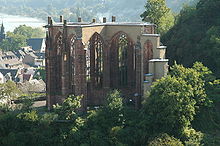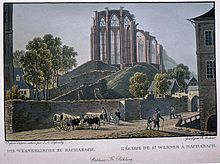Werner Chapel (Bacharach)
The Werner Chapel is a romantic landmark of the city of Bacharach am Rhein . It is on the way from the city to Stahleck Castle . She is the successor to a chapel dedicated to St. Kunibert at the same location . The ruin has meanwhile been secured according to the monument and has a plaque commemorating the inhuman crimes against the Jewish fellow citizens, with a prayer quote from Pope John XXIII. in which Christians are asked for a change of heart in their relationship with the Jews.
“Today we recognize that many centuries of blindness have covered our eyes so that we can no longer see the beauty of your chosen people and no longer recognize the features of our firstborn brother in their faces.
We see that there is a mark of Cain on our forehead. Over the centuries, our brother Abel has lain in the blood we shed and cried tears that we caused because we forgot your love. Forgive us the curse we wrongly attached to the names of the Jews. Forgive us that we crucified you a second time in her flesh. Because we didn't know what we were doing. "
backgrounds
A Latin chronicle from the 14th century reports an alleged sacrifice of the host , that citizens from Jewish communities hung Werner by his feet in Oberwesel in order to steal a host that he was about to swallow. Then they would have thrown him into the Rhine. In Bacharach, where the body is said to have washed ashore in 1287, it was buried at the Kuniberts chapel, which soon became a pilgrimage . With contributions from the pilgrims, the Werner chapel was built in place of the Kunibert chapel. The veneration of Werner was mainly anchored in popular Christianity; he was only deleted as a saint from the calendar of the Diocese of Trier in 1963 . But the "Saint Werner von Oberwesel" is still in German lists of saints, such as in the Ecumenical Lexicon of Saints.
History of the building

The construction of the Werner Chapel in contemporary Gothic style soon began . As early as 1293, a Werner altar was consecrated in the completed southern arm and in 1337 the east choir was consecrated. The chapel was only completed after 1426 at the instigation of the theology professor and humanist Winand von Steeg , who was pastor in Bacharach from 1421 to 1438. Two preserved Gothic architectural plans of the Werner Chapel, including the first draft that is one yoke longer, refer to the Münsterbauhütte in Strasbourg as the place of origin of the planning, and thus to Erwin von Steinbach as the author of the plan. Until the introduction of the Reformation in Bacharach, the chapel was a popular place of pilgrimage. In 1685, when the Catholic Princely House of Palatinate-Neuburg inherited the Palatinate, the chapel was assigned to the few Bacharach Catholics as a parish church, but as early as 1689 during the Palatinate War of Succession the chapel was damaged when Stahleck Castle was blown up and then fell into ruins. In 1759 the north arm had to be demolished because of the risk of collapse. In 1787 the remaining vaults and roofs were removed. With the advent of the romanticism of the Rhine , the ruins regained more interest, which was also reflected in a large number of pictorial representations in paintings, drawings, prints and, finally, early photographs. As a result of this "rediscovery", the first security measures were carried out in 1847, others followed in 1901. The last and most thorough security measures were carried out between 1981 and 1996, because the ruin was feared to collapse again. Due to the lack of the north apse, the statics had changed over time, which had led to deep cracks in the masonry, plus the progressive weathering. The initiator of the safeguarding campaign was the "Bauverein Wernerkapelle", which emerged from a citizens' initiative and which, with the help of the owner, the Catholic community, and the diocese, state and federal government and private donors , oversaw the 6 million mark project under the direction of Cologne cathedral builder Arnold Wolff .
Building description
The Werner chapel, made of red-white to red-yellow medium to fine-grained sandstone with earthy inclusions, which probably comes from the lower Main area or the northeastern Rhine-Palatinate, on a cloverleaf-like floor plan applies because of the clarity of the structure and the beauty of the Individual forms as one of the most perfect creations of the Rhenish Gothic. Regular apses are connected to the square crossing with a side length of about 8.60 m to the north, south and east. As the main choir, the east choir is extended by an intermediate yoke half the size of the crossing. On the western side, only a narrow yoke was possibly built on because of the narrowness of the building site. The western part, which was later completed, consists almost entirely of the local gray-wacke slate. The side walls are almost completely pierced by the high lancet windows with measure and framework, which also has a rich treasure trove of figures. The total height of the windows is about 12.20 m, the height of the wall up to the eaves about 18.15 m.
Werner and Werner Chapel in Art

The temporary art installation “THE FENSTER - Wernerkapelle Bacharach” by the artist Karl-Martin Hartmann turned the ruins into a meeting place for three years, to reflect on tolerance and to exchange ideas. Excerpts from Heinrich Heine's story “The Rabbi von Bacherach” could be read on the glass window, which was glowing red from far away. The installation was carried out without interfering with the structure of the building and existed from May 2007 to May 2010. During this time, lectures on fraternal interaction between religions and tolerance were held regularly in the ruins. Lecturers were u. a. Leo Trepp , Necla Kelek , Ruth Lapide , Gerhart Baum and Heidemarie Wieczorek-Zeul . At the closing event, Rabbi Leo Trepp accepted the first copy of a documentary on the art project and lecture series "with the greatest hope that the Werner Chapel will become a symbol of love, tolerance and equality". Another chapel dedicated to Werner von Oberwesel in the side of the city wall of Oberwesel facing the Rhine was renovated in 2001 and rededicated as the Mother Rosa Chapel in 2008 . A chapel is still dedicated to him at his birthplace.
Heinrich Heine processed the legend in his fragmentary story The Rabbi von Bacherach .
literature
- Julian Hanschke: Two medieval construction plans of the Werner chapel in Bacherach . In: INSITU. Zeitschrift für Architekturgeschichte 3 (2/2011), pp. 149–160.
- Hauke Horn: The Wernerkapelle zu Bacharach, in: ders., Baukultur am Mittelrhein, in: G. Huber-Rebenich u. a. (Ed.), Water in Medieval Culture. Use - perception - symbolism. Berlin / Boston 2017. pp. 170–177.
- Frieder Schwitzgebel: Tolerance in mind: The installation by Karl-Martin Hartmann in the Werner Chapel in Bacharach. In: Das Münster 62 (2009), Issue 1, ISSN 0027-299X , pp. 17-20.
- Tolerance in mind: Karl-Martin Hartmann's project in the Wernerkapelle Bacharach in cooperation with the Wernerkapelle building association. Published by Bauverein Wernerkapelle Bacharach e. V. University printing house H. Schmidt, Mainz 2010, ISBN 978-3-935647-49-6 .
- Friedrich Ludwig Wagner and Arnold Wolff: The Werner chapel in Bacharach on the Rhine. Neusser Druckerei u. Verl., Neuss 1983, ISBN 3-88094-428-8 (Rheinische Kunststätten; 276).
- Daniela Wolf: ritual murder affair and cult genesis: the 'good Werner von Oberwesel'. Bauverein Wernerkapelle, Bacharach 2002, ISBN 3-00-009539-X .
Web links
- Werner Chapel on regionalgeschichte.net
Individual evidence
- ↑ Pope John XXIII: Penitential prayer "We recognize ..." Spoken on June 3, 1963 at the 2nd Vatican Council, accessed on October 22, 2016.
- ↑ Werner in the Ecumenical Saint Lexicon , accessed on December 10, 2012
- ↑ to link regional history
- ↑ Julian Hanschke: Two medieval construction plans of the Werner chapel in Bacharach. Insitu - Journal for Architectural History, III (2011): 149–160
- ^ Rescue of the Werner chapel from regional history by Peter Keber
- ↑ Stone material from Fraunhofer building information (accessed August 2013)
- ^ Werner chapel near Bacharach, Middle Rhine
- ↑ Description of the property with building information
- ↑ Karl-Martin Hartmann, tolerance before eyes - Wernerkapelle, Bacharach . Retrieved June 10, 2010.
- ↑ Removed exclamation mark . In: Allgemeine Zeitung (Rhineland-Palatinate) , May 25, 2010. Accessed June 10, 2010.
- ^ City of Bacharach, Bauverein Wernerkapelle Bacharach e. V., Rhein-Nahe Touristik, Bacharach: The window - Wernerkapelle Bacharach ( Memento from July 24, 2011 in the Internet Archive ); bacharach.de
Coordinates: 50 ° 3 ′ 34.1 ″ N , 7 ° 46 ′ 1.6 ″ E



